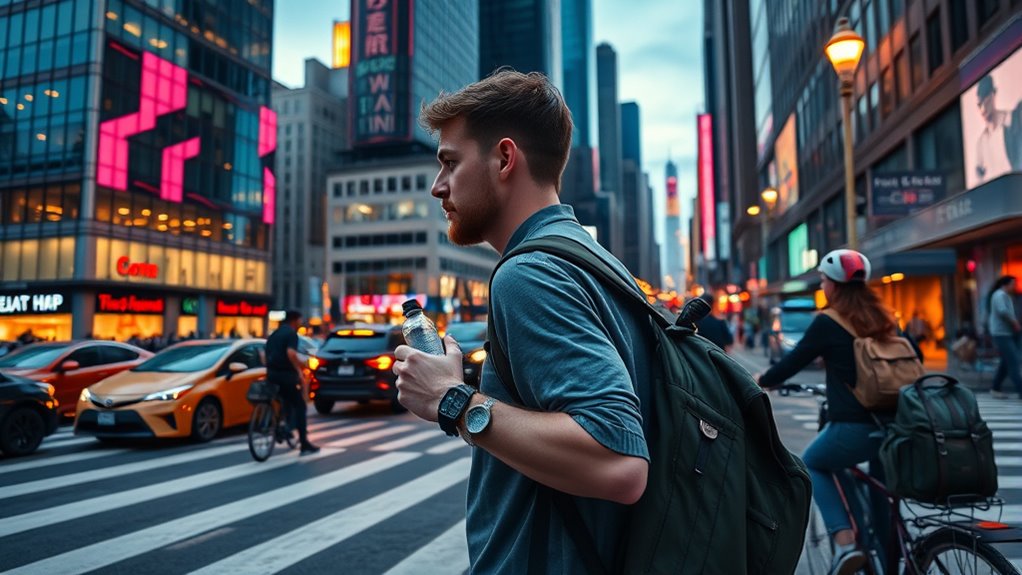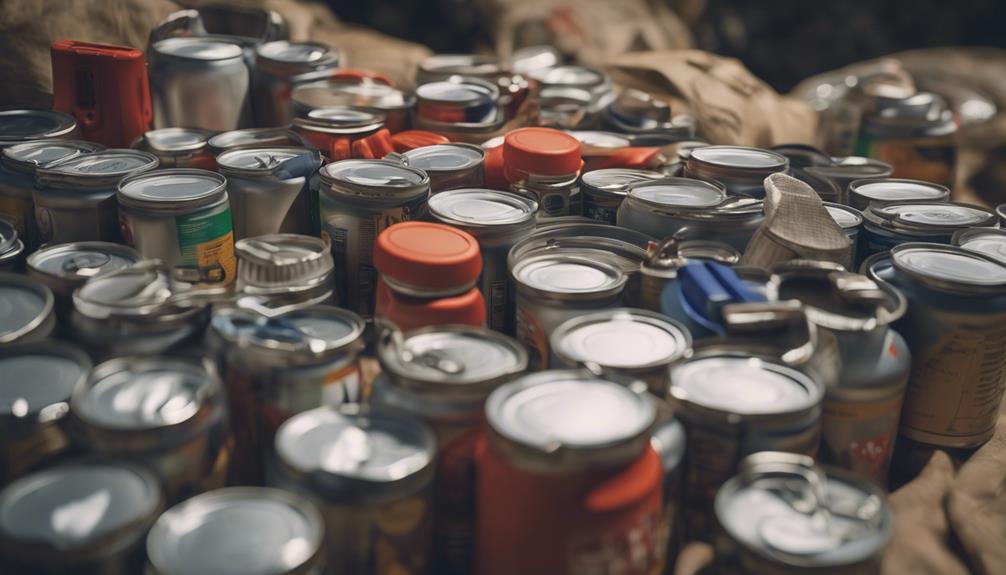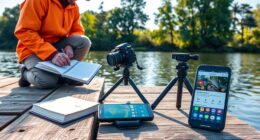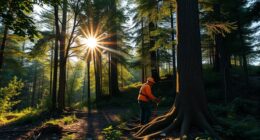To survive in the city, you need to master shelter security, secure and purify water, find and prepare food through urban foraging and gardening, and stay alert to threats. Develop skills in concealment, self-defense, and first aid to protect yourself. Enhancing your situational awareness and stress management keeps you calm under pressure. If you keep exploring, you’ll discover how to build resilience and adapt quickly when chaos hits.
Key Takeaways
- Identify and reinforce safe shelters with multiple escape routes, prioritizing upper floors and barricadable entrances.
- Secure and purify water from natural sources, rainwater, or contaminated city water using boiling, chemicals, or filtration.
- Forage for edible plants, fruits, and small aquatic life in neglected areas, ensuring proper identification and preparation.
- Practice discreet movement by blending into crowds, dressing neutrally, and avoiding loud noises or eye contact.
- Establish reliable food and water storage, utilize urban resources like abandoned stores, and grow food through container gardening.
Securing and Purifying Water in the City

How can you guarantee safe drinking water in an urban survival situation? In the city, water sources may be contaminated or unavailable, so you need to identify natural sources like lakes, ponds, or where rivers enter urban areas. Collect water from the start of these streams to minimize pollutants and debris. Always purify water before drinking—boiling for 1-2 minutes, using purification tablets, or adding bleach in the correct amount are effective methods to eliminate bacteria and pathogens. Carry portable water purification supplies, such as tablets, filters, or chemical kits, in your bug-out bag for quick access. Avoid questionable sources like puddles, drainage ditches, or unverified containers to prevent illness. Proper water purification is essential for staying healthy during urban emergencies. Utilizing advanced water treatment solutions can further ensure the safety of your water supply in critical situations. Additionally, understanding vehicle-based water filtering methods can be highly beneficial if you need to adapt your approach in a city environment. Knowing how to assess water quality quickly can help you make informed decisions about water sources in an emergency.
Locating and Preparing Food Sources

In urban survival, finding food means identifying edible plants in parks or alleyways and learning to distinguish safe options from poisonous ones. You can also grow your own food by planting seeds from discarded packaging or grocery stores, creating a sustainable source over time. Additionally, fishing in city waterways or raising small livestock like chickens and rabbits can provide reliable protein and nutrients. To optimize your efforts, it’s helpful to understand basic foraging techniques and how to recognize native edible plants. Building your knowledge of urban ecology can enhance your ability to identify safe food sources and avoid hazards. Developing an understanding of local plant varieties is crucial for successful and safe foraging in city environments. Implementing fraud prevention tools can also ensure your food sources remain secure and untainted, especially when dealing with unfamiliar suppliers or resources. Learning about native plant identification can further improve your foraging success and safety.
Urban Foraging Opportunities
Urban foraging presents a practical way to find food in city environments by identifying edible plants and natural resources. You can spot edible plants like dandelions, wild garlic, and purslane growing in parks, vacant lots, and even cracks in sidewalks. Fruits from trees such as crabapples, mulberries, and invasive blackberries are often available in neglected areas. Don’t overlook city waterways and drainage ditches, which may harbor fish or shellfish you can catch with simple gear. However, always be sure to positively identify edible plants and avoid those contaminated by pollutants or chemicals. Proper preparation, like thorough washing or cooking, is vital to eliminate dirt, bacteria, and toxins. Understanding the foraging range of local wildlife can also help you locate reliable food sources in urban areas. Additionally, being aware of pollution levels in your environment is crucial to ensure the safety of foraged foods. Regularly checking soil contamination levels can help prevent exposure to harmful substances. Being familiar with pollutant sources in urban settings can further guide safer foraging practices. Incorporating knowledge of seasonal variations can further optimize your foraging success throughout the year. Urban foraging offers a valuable supplement to your food sources when done safely and responsibly.
Sustainable Gardening Techniques
To establish sustainable food sources in limited spaces, you can create container gardens on balconies, rooftops, or windowsills using soil, compost, and heirloom seeds suited for small areas. Urban gardening allows you to grow edible plants like herbs, lettuce, tomatoes, and root vegetables, providing fresh nutrition while reducing trips to the store. To conserve water, collect rainwater for irrigation, which supports plant health and minimizes reliance on city supplies. Using compost made from human and animal waste, after proper treatment, enriches your soil and boosts crop growth. Incorporating urban farming techniques can further enhance your food production efficiency and sustainability in confined city environments. These techniques help you produce food sustainably, even in confined city environments, and understanding how to identify spoilage in your stored food can help prevent waste and ensure your harvest remains safe to eat. Additionally, selecting innovative planter designs can optimize space and improve plant growth in limited areas. For example, choosing the right soil mixture is crucial for supporting healthy seed germination and growth. Employing vertical gardening methods can maximize limited space and increase crop yields effectively.
Water and Food Storage
Have you identified reliable sources of water and food in your environment before a crisis occurs? Securing water and food storage is essential for urban survival. Store at least two weeks’ worth of non-perishable food like canned goods, dried grains, and preserved items to ensure long-term sustenance. Look for natural food sources such as city waterways for fishing and urban foraging for edible plants, fruits, and nuts. Collect rainwater using gutters, barrels, or containers, and always purify it with boiling, chemicals, or filtration before drinking. Use scavenged or stored seeds to establish a sustainable garden in available soil or containers, supplementing with compost and natural fertilizers. Prioritize securing water and food early, utilizing abandoned stores, markets, or other urban resources to build a resilient supply chain. Additionally, considering options like electric bikes, which can aid transportation and resource gathering in urban environments, can enhance your survival capabilities. Being aware of food preservation techniques can help extend your supplies and reduce waste during emergencies. Implementing urban foraging strategies can uncover additional edible resources in unexpected places. Incorporating portable water filtration systems can further ensure access to clean drinking water in unpredictable situations. Moreover, use energy-efficient appliances, such as heat pumps, to reduce energy consumption and maintain a sustainable living environment during extended crises.
Building and Finding Safe Shelters
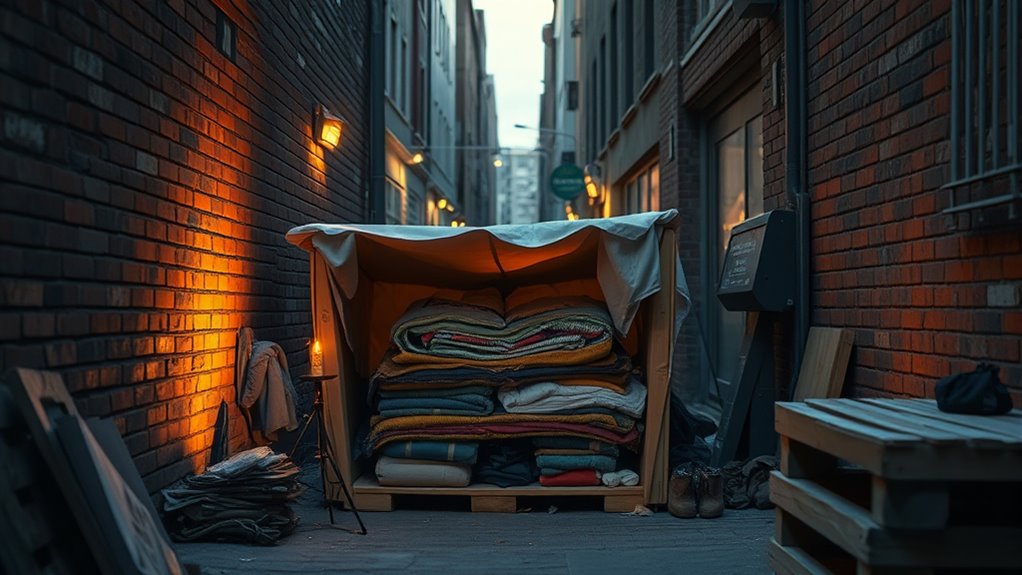
Wondering where to find the safest spot to take cover? In urban survival, buildings are your best options for shelter. Prioritize multi-story structures with barricadable entrances and multiple escape routes, like stairwells and fire escapes, to stay mobile and safe. Reinforce doors, windows, and walls using furniture, crates, or debris to create makeshift barriers against intruders or hazards. Elevate your shelter by using rooftops or upper floors, reducing ground-level threats and offering vantage points to monitor your surroundings. Seek abandoned or less-visited structures such as warehouses or parking garages, which often provide concealment and resources. Ensure your shelter has access to water, ventilation, and natural light whenever possible. Consider establishing multiple fallback locations within the city for long-term safety and peace of mind.
Developing Self-Reliance and Repair Skills

Developing self-reliance and repair skills is essential for urban survival, especially when professional services may be unavailable. By learning basic plumbing, electrical, and carpentry skills, you can repair and maintain crucial infrastructure during emergencies. Practicing DIY repairs with common tools and materials helps extend the life of household items, reducing dependency on specialists. Craftsmanship skills like sewing, woodworking, or metalworking enable you to create makeshift solutions and customize survival gear. Additionally, understanding natural and alternative repair methods, such as natural adhesives or repurposing materials, boosts your resourcefulness. Building a versatile toolkit with pry bars, multi-tools, and water keys prepares you to fix, open, or modify urban structures when needed. These repair skills reinforce your self-reliance and resilience in urban survival situations.
Enhancing Situational Awareness and Threat Detection

To stay safe in urban environments, you need to recognize early signs of threats, like unusual behavior or sudden environmental shifts. Pay close attention to people’s routines and body language to identify potential allies or dangers. Familiarize yourself with the area to quickly spot changes and plan safe responses.
Recognize Early Threat Signs
Recognizing early threat signs in urban environments requires your keen observation and quick assessment of changing conditions. Watch for suspicious activity, such as individuals loitering near critical facilities or acting unusually. Environmental cues like strange noises, odors, or debris movement can signal danger. Sudden surges in panic behavior, including large groups gathering unexpectedly or people fleeing, often indicate an imminent threat. Notice changes in infrastructure, such as power outages or vehicles shutting down, which may point to a developing crisis. Also, observe shifts in human or animal behavior, like increased agitation or fleeing, as signs of escalating danger. Staying alert to these early warning signs enhances your ability to respond promptly and avoid potential threats in the city.
Observe Behavioral Patterns
Have you ever noticed how people’s behaviors can reveal their true intentions in an urban environment? By observing routines, suspicious behavior, and body language, you can enhance your situational awareness. For example, someone pacing nervously or avoiding eye contact may signal agitation or concealment. Recognizing deviations from normal routines—like unusual activity or erratic movements—helps identify risks early. Body language cues, such as clenched fists or tense postures, often hint at hostility or violence. Also, watch how groups interact; secretive exchanges or silence might indicate planning or criminal intent. Understanding these patterns allows you to respond swiftly and stay alert. Here’s a quick guide to behavioral cues:
| Body Language | Routines | Suspicious Behavior |
|---|---|---|
| Clenched fists | Walking in established paths | Loitering without purpose |
| Tense posture | Regular transit times | Avoiding surveillance |
| Covert glances | Daily habits | Unusual gatherings |
| Nervous pacing | Typical social interactions | Sudden movements |
Assess Environmental Changes
By paying close attention to environmental cues, you can substantially improve your situational awareness and spot potential threats early. Look for signs of environmental hazards like fallen trees, chemical spills, or structural damage that could threaten safety or require evacuation. Be alert for unusual quietness, sudden crowd movements, or damaged infrastructure, which serve as early warnings of urban crises. Monitor for electromagnetic pulse (EMP) effects, such as vehicle shutdowns or electronic failures, indicating potential threats. Watch for changes in human behavior, like increased agitation or uncharacteristic activity, signaling impending danger. Use mapping tools, reconnaissance, and city layouts to identify escape routes, safe zones, and hazard areas. Recognizing these signs helps you respond swiftly and avoid unnecessary risks during environmental changes.
Reading People and Assessing Behavior

Ever wonder how to tell if someone in an urban environment is trustworthy or a threat? It starts with observing body language—nervous gestures, facial expressions, and eye contact reveal a lot. Pay attention to behavior patterns; frequent visits to certain spots or inconsistent stories can signal hidden motives. Noticing signs of distress, agitation, or fatigue helps you assess whether someone might be unstable or dangerous. Reactions to environmental stimuli, like loud noises or strangers approaching, also offer clues about their intentions. Over time, tracking these cues sharpens your threat assessment skills. Recognizing subtle signals and understanding behavioral patterns enable you to make smarter decisions, stay alert, and keep yourself safe amidst the unpredictability of city life.
Mastering Concealment and Discretion

To master concealment and discretion, you need to blend seamlessly into your environment by dressing plainly and avoiding anything that draws attention. Moving quietly and using shadows, alleyways, or crowds helps you stay hidden from potential threats. Paying close attention to human behavior allows you to anticipate danger and adjust your movements to remain unnoticed.
Blending Into Environment
Mastering concealment in an urban environment requires you to dress in neutral, non-tactical clothing that blends seamlessly with your surroundings. To achieve this, choose clothing without bright colors or prominent logos, helping you maintain discretion. Your goal is to blend into the environment, using natural cover like crowds, parked vehicles, or shadows to stay inconspicuous. Move deliberately, avoiding open spaces and well-lit areas that could expose you. Keep your body language subtle—minimize noise, avoid eye contact, and use discreet movements to prevent drawing attention. Regularly assess your situation, adapting your appearance and behavior to match the changing environment. By controlling your presentation and leveraging natural cover, you enhance your ability to blend seamlessly into the urban landscape.
Avoiding Attention Strategically
In urban settings, avoiding attention requires deliberate effort to stay unnoticed. You can achieve this by using a simple disguise—wear plain, neutral clothing without logos or bright colors—so you blend in seamlessly. Maintaining a low profile means avoiding loud noises, unnecessary gestures, or eye contact that might draw eyes your way. Develop a “gray man/woman” persona by acting inconspicuously and blending into your surroundings, regardless of the situation. Keep your gear minimal and concealed, avoiding displays of weapons or survival tools unless absolutely necessary. Use natural cover and shadows to hide your movements, especially at night or in crowded areas. By consciously controlling your appearance and behavior, you reduce the chance of standing out and increase your safety in urban environments.
Managing Personal Discretion
Managing personal discretion is essential for staying unnoticed in urban environments. You want to blend in smoothly, avoiding anything that draws attention. Develop a “gray man/woman” persona by steering clear of flashy clothing or accessories like tactical gear or bold jewelry. Adjust your behavior and appearance based on your surroundings, maintaining calm, neutral expressions and avoiding unnecessary gestures. Use natural cover such as shadows, crowds, or urban debris to hide your movements and intentions from potential threats or prying eyes. Minimize the use of electronic devices or conspicuous items that could reveal your location. Practice situational awareness by monitoring your environment, avoiding repetitive routines, and choosing routes that keep you less predictable. Mastering discretion helps you stay under the radar and navigate urban spaces safely.
Strengthening Mental Resilience and Stress Management

How can you strengthen your mental resilience and stay calm amid urban crises? Building emotional stability requires practicing stress management techniques like deep breathing, meditation, or visualization to stay clear-headed. Regular mental rehearsal of emergency scenarios helps you respond calmly and effectively under pressure. Cultivating a positive outlook and focusing on achievable survival goals reduces anxiety and prevents panic. Recognizing that impermanence is natural helps you accept change and adapt more easily. Maintaining strong social connections provides emotional support, bolstering your mental resilience during high-stress situations. Consider these strategies:
Strengthen mental resilience through mindfulness, visualization, realistic goals, embracing change, and building strong support networks.
- Practice mindfulness and breathing exercises daily
- Visualize successful responses to emergencies
- Set realistic, achievable survival goals
- Embrace change as a natural part of life
- Build a trusted support network
These steps help you stay emotionally stable and resilient when it matters most.
Applying Self-Defense and Personal Security Measures
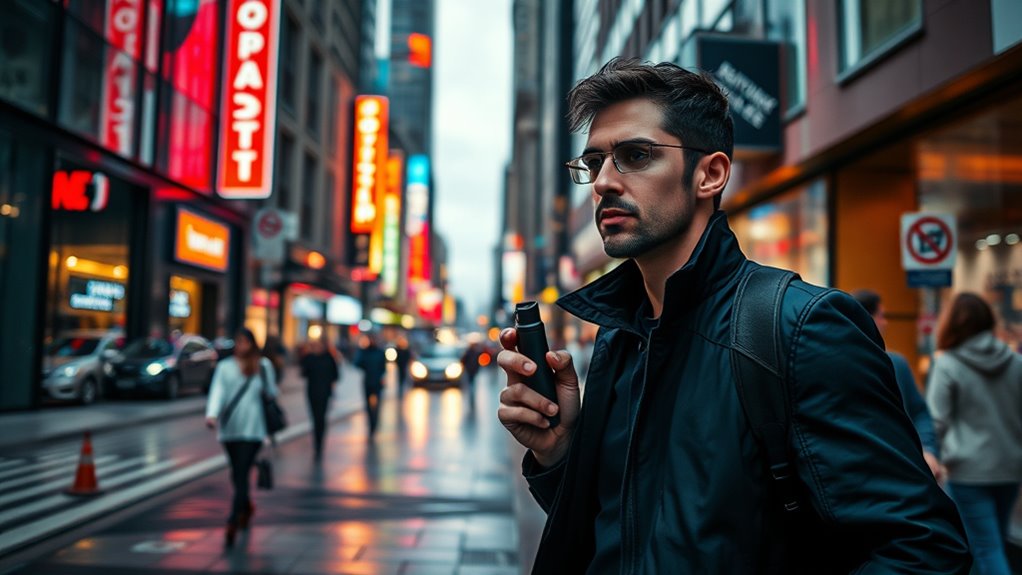
Enhancing your personal security in urban environments involves adopting practical self-defense skills and awareness strategies. Learning techniques like Judo, Jiu-Jitsu, or MMA boosts your confidence and effectiveness during threats. Carrying simple tools such as tactical pens, pepper spray, or knives offers accessible personal security options without escalating violence. Recognizing when to fight or flee based on threat assessment is vital; often, evasion is safest. Maintaining situational awareness helps you spot dangers early and avoid confrontations. Take self-defense courses from qualified instructors to sharpen your reflexes and response skills.
| Action | Benefit |
|---|---|
| Learn self-defense | Improves response and confidence |
| Carry tools | Provides quick options for personal security |
| Stay aware | Helps avoid dangerous situations early |
Acquiring Basic Medical and First Aid Skills

Knowing basic first aid skills can be a lifesaver in urban emergencies. Being prepared means mastering techniques like applying pressure to stop bleeding, clearing airway obstructions, and treating burns quickly. You should carry a well-stocked medical kit with essentials such as bandages, antiseptic wipes, gloves, pain relievers, and medications for common injuries. Learning how to perform CPR and use an AED can considerably increase survival chances during cardiac incidents. Recognize signs of shock, dehydration, and poisoning, and know immediate steps to stabilize affected individuals. Regularly practicing these skills through online courses or workshops keeps you ready. Remember, your quick response can make a real difference in critical moments. Staying informed and prepared ensures you’re capable of handling urban medical emergencies confidently.
Frequently Asked Questions
What Are the 5 Most Important Survival Skills?
The five most important survival skills include mastering situational awareness so you can spot threats early, developing self-defense techniques to protect yourself, learning water purification methods for safe drinking water, building basic shelter and fire-starting skills for warmth and safety, and cultivating mental resilience to stay calm and adaptable during crises. These skills guarantee you’re prepared to handle emergencies effectively and increase your chances of staying safe.
How to Survive in Urban Areas?
Surviving in urban areas isn’t just about avoiding danger—it’s about mastering chaos. You need to stay alert, recognize hazards like violence or infrastructure failures, and prioritize essentials like water, food, and shelter. Develop multiple escape routes, read social cues, and stay prepared with self-defense skills. Ironically, being overly cautious can keep you safe, but knowing when to act swiftly makes all the difference in the city’s unpredictable landscape.
What Is an Urban Survivalist?
An urban survivalist is someone who prepares for emergencies specifically within city environments. You focus on developing skills like situational awareness, threat assessment, and resourcefulness to navigate hazards. You learn to source water, food, and shelter from urban infrastructure, practice self-defense, and stay stealthy to avoid danger. Your goal is to stay safe, self-sufficient, and resilient, making the most of your environment during crises or disasters.
What Is the Difference Between Survival Skills and Bushcraft Skills?
You might wonder about the difference between survival skills and bushcraft skills. Survival skills focus on quickly addressing immediate needs like water purification, shelter, and self-defense, especially in urban environments. Bushcraft skills, on the other hand, involve long-term outdoor techniques such as fire-making and trapping. While both require resource knowledge, survival skills adapt to man-made settings, helping you navigate city hazards, while bushcraft prepares you for wilderness self-reliance.
Conclusion
In an urban survival situation, your ability to adapt and stay alert can make all the difference. Are you prepared to rely on your skills and instincts when it counts most? By mastering water purification, self-defense, and mental resilience, you’ll increase your chances of staying safe and thriving amid chaos. Remember, the key to urban survival lies in constant learning and quick action—so stay vigilant and keep honing your skills.

